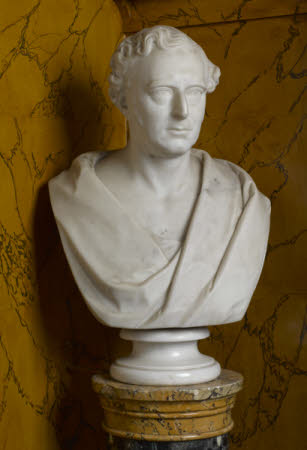Portrait bust of Robert Stewart, 2nd Viscount Castlereagh, later 2nd Marquess of Londonderry (1769-1822)
attributed to Thomas Kirk RHA (Cork 1781 - Dublin 1845)
Category
Art / Sculpture
Date
c. 1820 - 1830
Materials
Marble
Measurements
717 x 482 mm
Place of origin
Dublin
Order this imageCollection
The Argory, County Armagh
NT 565211
Summary
Sculpture, marble; Portrait bust of Robert Stewart, 2nd Viscount Castlereagh, later 2nd Marquess of Londonderry (1769-1822); attributed to Thomas Kirk RHA (Cork 1781 – Dublin 1845); c. 1820-30. A portrait bust of the politician and statesman Viscount Castlereagh, who was instrumental in enabling the passing of the Act of Union by the Irish Parliament. Subsequently, Castlereagh became one of the key participants in the negotiations at the Congress of Vienna following the defeat of Napoleon Bonaparte. The bust may well be be the work of the Cork-born sculptor Thomas Kirk.
Full description
A marble portrait bust probably depicting Robert Stewart, 2nd Viscount Castlereagh, later 2nd Marquess of Londonderry (1769-1822), attributed to Thomas Kirk. The sitter is depicted looking slightly to his left, his hair combed back at the forehead, wearing a loose drapery. Mounted on a white turned marble socle, displayed on a scagliola half-column. This portrait bust is unsigned and the identity of the sitter has until now been uncertain, with George Canning (1770-1827) having been suggested as an alternative. However, the prominent Roman nose, the thick vigorously curling hair and thick bushy eyebrows, and the direct gaze would suggest that it is most likely to depict Robert Stewart, 2nd Viscount Castlereagh, later 2nd Marquess of Londonderry. The identification is not entirely certain, since the way in which the hair is combed from the side of the forehead is not seen in the better-known portraits of Castlereagh, nor is he portrayed with such prominent sideburns. Nevertheless, the juxtaposition of the bust at the Argory with a portrait bust of William Pitt suggests that the subject was a leading political figure of the time. It seems even less likely to be a portrait of George Canning, who was bald from an early age and whose nose was straight. The most probable identification would seem to be Lord Castlereagh, later the second Marquess of Londonderry, not least since the bust seems always to have been displayed as a pair with a portrait bust of William Pitt by Joseph Nollekens (NT 565212), until 1916 at Drumsill House and subsequently in the West Hall at the Argory. Both men were among the chief architects of the Act of Union of 1800, the pairing itself therefore strengthening the probability that the subject is Viscount Castlereagh. Perhaps the sculptor had not seen Castlereagh in person and was not deeply familiar with his portrait. Viscount Castlereagh was born Robert Stewart, the only surviving son from the first marriage of the 1st Marquess of Londonderry. He is the key figure in the history of the Londonderry family. In 1790 he entered Parliament as MP for Co. Down, enjoying a meteoric rise through British politics and becoming Prime Minister in all but name. In 1798, as Chief Secretary to the Lord Lieutenant of Ireland, Stewart was wrongly blamed for the violence used to suppress the rebellion that year in Ireland. However, he supported the union of Ireland with Britain and was subsequently instrumental in ensuring the passing of the Act of Union. Except for the period 1809-12, Castlereagh was a member of the British cabinet continuously from 1802, until his death in 1822 by suicide, driven by overwork, anxiety and hostility engendered by his efforts on behalf of Catholic Emancipation. In 1812 he returned to government as Foreign Secretary, in which post he helped to bring the Napoleonic wars to a conclusion, before playing a key part in the Congress of Vienna, which aimed not only to reach a settlement with France but also to create a balance of power, which would help to ensure a more lasting peace in Europe, as it indeed did. Lord Castlereagh had a reputation as a staunch reactionary and tended to excite violent reactions in others, enthusiasm from some, condemnation on the part of others. On the death of his father in 1821, just over a year before his own demise, he succeeded as 2nd Marquess of Londonderry. A portrait bust of Castlereagh by Joseph Nollekens, dated 1809, is at Mount Stewart (NT 1220131), whilst in National Trust collections there are a number of versions of his outstanding sculpted portrait by Francis Chantrey - at Mount Stewart (NT 1542341), Ickworth (NT 852242) and Powis Castle (NT 1185532). If the Argory portrait does depict Castlereagh, it was clearly made around the time of Chantrey’s portrait, commissioned in 1821, thus at the very end of the sitter’s life. It may well be identifiable with the undated portrait of Castlereagh that the sculptor Thomas Kirk was recorded by Walter Strickland as having made. Walter McGeough Bond was an important patron of Kirk in the 1820s, acquiring at least three sculptures from him, two marbles of a small boy, both made in 1826 (NT 565244 and 565245), and a portrait bust of Horatio Nelson, dated 1822 (NT 565241). There are quite strong parallels with Kirk’s portrait of Nelson in the handling of the surface of the bust. Jeremy Warren November 2022
Provenance
By descent at Drumsill House; to the Argory in 1916; Walter McGeough Bond (1908-86), by whom given to the National Trust in 1979.
Makers and roles
attributed to Thomas Kirk RHA (Cork 1781 - Dublin 1845), sculptor
References
Strickland 1913: W. G. Strickland, Dictionary of Irish Artists, 2 vols.1913, I, p. 589.
